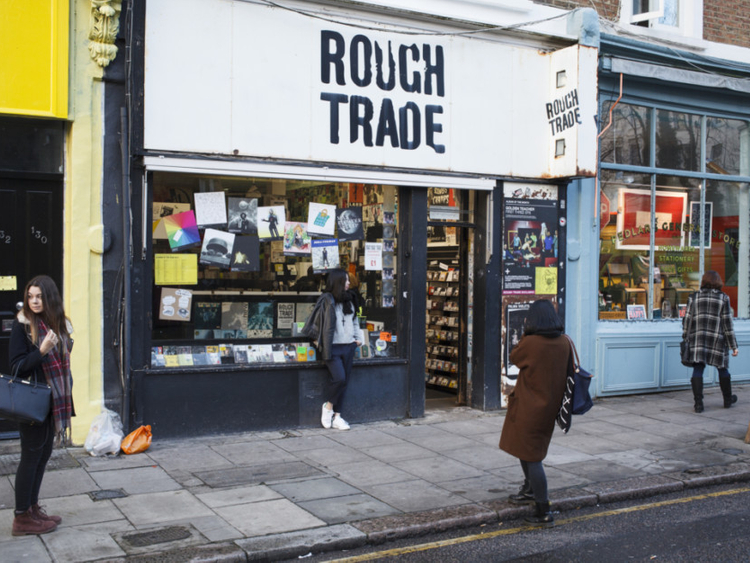
The Sex Pistols and The Clash led the British punk rock revolution in the steamy summer of 1976. London is marking 40 years since that summer with a series of events, gigs and exhibits this year.
As an early fan of punk, I set out on a personal pilgrimage to explore the neighbourhoods and locations that were its petri dishes — from the Pistols’ rehearsal and living space to the scene of the Notting Hill riots witnessed by The Clash to the pubs and clubs that hosted their first shows.
In some places, I found the opposite of the angry energy that inspired anthems like the Pistols’ Anarchy in the UK and The Clash’s London’s Burning. But I also found some venues still going strong.
First stop: Portobello Road to see the mural of Clash frontman Joe Strummer, which was painted after this death. Sadly, when I visited, it was mostly covered by scaffolding. I looked in vain for signs of Strummer’s anti-establishment vibe, but all I found was a bustling market selling knick-knacks, clothing and antiques while passers-by peered at their iPhones. From there I headed to Tavistock Road, the street that inspired Strummer’s White Riot, his call to arms after a West Indian carnival ended in riots in Notting Hill in the summer of ‘76. But I failed to find any sign of punk’s past on the quiet thoroughfare, so I settled in the Metropolitan Pub on Great Western Road for a hand-pulled pint.
The Rough Trade record shop opened in 1976 on Kensington Park Road. Today it’s on Talbot Road, filled with vinyl and CDs, its walls and ceiling adorned with posters featuring The Clash, Sex Pistols and others.
In Central London, I marvelled at the fine instruments at NO.TOM, a small guitar shop on Denmark Street, near the Tottenham Court Road tube. The short street, once known as London’s Tin Pan Alley, was home to many music publishers and studios. Behind NO.TOM there’s a tiny 19th century cottage where the Sex Pistols once lived. It’s covered with graffiti created by the Pistols’ John Lydon (Johnny Rotten), including a drawing of the Pistols’ manager Malcolm McLaren, and another of Nancy Spungen, Sid Vicious’ girlfriend.
At 100 Oxford St., the 100 Club is marked with a sign and poster for upcoming shows. The Sex Pistols played here in May 1976 and the venue hosted a punk festival in the fall of ‘76. In January 2016, ‘70s bands including 999, The Members, UK Subs and Discharge played here as part of a punk series.
In Chelsea, at 430 King’s Road, a giant “SEX” sign once hung outside a shop of the same name shared by McLaren, the Pistols’ manager, and designer Vivienne Westwood. Westwood still runs a boutique here called Worlds End.
Next stop: Camden Market. Today this thriving collection of bars, restaurants, shops and stalls is overrun with shoppers perusing all types of food and fashion, from espresso to T-shirts bearing the Union Jack. I was here to find the spot where The Clash posed for a photograph that became an iconic image adorning their first album. The photo was taken on a ramp that’s since been converted to steps. I took a selfie standing there but couldn’t help feeling a pang of regret. My favourite band, often called “the only band that matters,” once stood here on the cusp of fame, but today the spot seems to embody the opposite of punk’s anti-materialistic message. And I had become part of the iPhone-toting tribe intent on the next purchase and picture. Where was the Pistols’ Anarchy in the UK? Where were All The Young Punks from The Clash song?
Maybe they were up the road at the Roundhouse. This fine music venue, originally a 19th century railway repair facility, has hosted performers since 1966. The Clash played their fifth-ever show here in September 1976. The Pistols, The Damned, The Ramones and Patti Smith all played here too. A Punk Weekender scheduled here for July 9 and 10 features music, prose and poetry as part of London’s 40-year anniversary celebration.
My final destination was London’s Islington neighbourhood, home to the Hope and Anchor pub, 207 Upper St., and Screen on the Green, 83 Upper St.
Hope and Anchor has a lovely ground-floor pub with a small theatre space upstairs and music venue in the basement. The basement’s roster has included The Jam, The Ramones, The Police, The Stranglers, XTC, U2, The Cure, Joy Division and The Pogues. Hope and Anchor also hosted pre-punk bands playing what was called pub rock, including a group led by Joe Strummer, the 101ers. The pub’s Facebook page lists upcoming shows, and today’s audiences aren’t likely to be hit by flying sheets of spit (“gob” as the Brits call it) the way they were in the early punk era, with fans gobbing at performers and musicians spitting right back.
Screen on the Green, with a fabulous neon facade, hosts movies and live events. It’s one of the oldest cinemas in the UK. The Clash, Sex Pistols and Buzzcocks played together there on the night Aug. 29, 1976. It was the end of the long, hot summer when punk was born.










